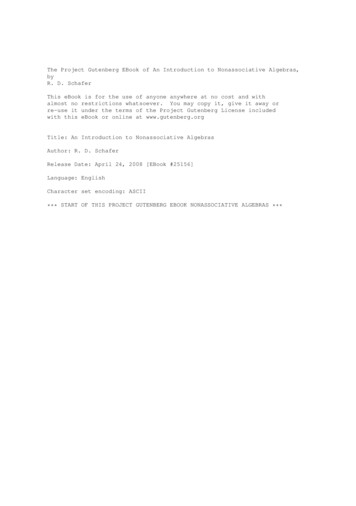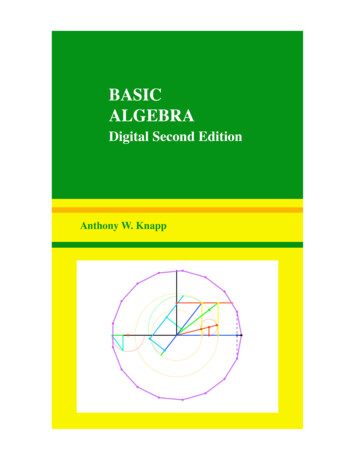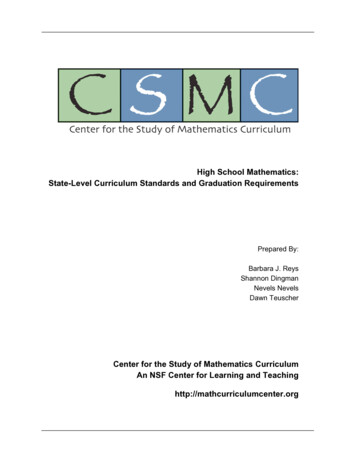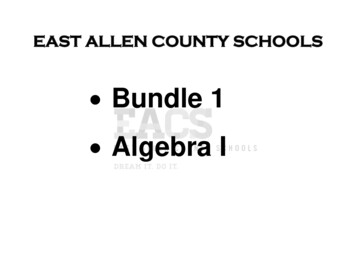
Transcription
Algebra 2Semester 2
Algebra 2 Semester 2Common Core State Standards InitiativeCOURSE DESCRIPTIONAlgebra 2 Semester 2Will meet graduation requirements forAlgebra 2Subject Area: MathematicsCourse Number: 1200330Course Title: Algebra 2 Semester 2Credit: 0.52
Algebra 2 Semester 2 IntroductionAmerican Worldwide Academy’s math course, AWA Algebra 2, focuses on thefundamental skills that are necessary for understanding the basics of algebra. This Study guideaddresses essential standards of mathematics, such as number quadratic equations,exponential and logarithmic functions, and conic sections. AWA Algebra 2 is full of practical,useful information geared to helping students recover credit for algebra while mastering thebasics. This Study guide will be helpful to any student who has previously had difficulties withunderstanding algebraic concepts and skills.There are six sections that cover core topics of algebra at the second course level. At thebeginning of each section of study, you will see the objectives outlined that will help you masterthe standards for the section.3
Algebra 2 Semester 2 Course ObjectivesAfter completion of this course, students will know and be able to do the following:Algebra Standards and Concepts Section 4: Quadratic Equations Students draw graphs of quadratic functions. They solve quadratic equations and solve theseequations by factoring, completing the square and by using the quadratic formula. They also usegraphing calculators to find approximate solutions of quadratic equations. Solve quadratic equations over the real numbers by factoring, and by using the quadraticformula. Solve quadratic equations over the real numbers by completing the square. Use the discriminant to determine the nature of the roots of a quadratic equation. Solve quadratic equations over the complex number system. Identify the axis of symmetry, vertex, domain, range and intercept(s) for a given parabola. Solve non-linear systems of equations with and without using technology. Use quadratic equations to solve real-world problems. Solve optimization problems. Use graphing technology to find approximate solutions of quadratic equations. Section 5: Logarithmic and Exponential Functions –Students understand the concepts of logarithmic and exponential functions. They graph exponentialfunctions and solve problems of growth and decay. They understand the inverse relationship betweenexponents and logarithms and use it to prove laws of logarithms and to solve equations. They convertlogarithms between bases and simplify logarithmic expressions. Define exponential and logarithmic functions and determine their relationship. Define and use the properties of logarithms to simplify logarithmic expressions and to find theirapproximate values. Graph exponential and logarithmic functions. Prove laws of logarithms. Solve logarithmic and exponential equations. Use the change of base formula. Solve applications of exponential growth and decay. Section 6: Conic Sections –Students write equations and draw graphs of conic sections (circle, ellipse, parabola, and hyperbola),thus relating an algebraic representation to a geometric one. Write the equations of conic sections in standard form and general form, in order to identify theconic section and to find its geometric properties (foci, asymptotes, eccentricity, etc.). Graph conic sections with and without using graphing technology. Solve real-world problems involving conic sections.4
Algebra 2 Semester 2 Getting StartedYou will learn much from this course that will help you in your future studies and career.In addition to reviewing and completing the study guide and textbook, your Final Examinationwill be evidence that you have mastered the standards for algebra. You will know the conceptsand be able to do the skills that will earn you one full credit for Algebra 2.If you are ready to begin, turn to the next page in this Study guide: the Progress Chartand Self-Test Schedule, which will serve as a guide to help you move through the course. Let’sget started on earning that algebra credit—good luck!5
Algebra 2 Semester 2Complete and Review:Solving Quadratic EquationsFactoringThe Quadratic FormulaCompleting the squareWork out all examplesThe DiscriminantDiscriminantOne real solutionTwo real solutionsNo real solutionsExponential FunctionsDefinitionGraph and PropertiesLogarithmic FunctionsDefinitionGraph and PropertiesLogarithmic scaleNatural logarithmsBase “a” to base “e”Conic SectionsDefinitionsEquation formParabolasKey pointsGeneral formGraphingExamplesCirclesKey pointsGeneral formGraphingExamplesEllipsesKey pointsGeneral formGraphingExamplesHyperbolasKey pointsGeneral formGraphingExamplesRecord Your Progress:Date completed: / /Date completed: / /Date completed: / /Date completed: / /Date completed: / /Date completed: / /Date completed: / /Date completed: / /Date completed: / /Date completed: / /Date completed: / /Date completed: / /Date completed: / /Date completed: / /Date completed: / /Date completed: / /Date completed: / /Date completed: / /Date completed: / /Date completed: / /Date completed: / /Date completed: / /Date completed: / /Date completed: / /Date completed: / /Date completed: / /Date completed: / /Date completed: / /Date completed: / /Date completed: / /Date completed: / /Date completed: / /Date completed: / /Date completed: / /Date completed: / /Date completed: / /Date completed: / /6
Algebra 2 Semester 2Table of ContentsContent Review for Section 4: Quadratic EquationSolving Quadratic Equations 8The Quadratic Formula . 10Completing the Square. .The Discriminant. 1513Content Review for Section 5: Logarithmic & Exponential FunctionsExponential Functions. . 18Logarithmic Functions . 19Content Review for Section 5: Conic SectionsOverview. . 24Parabolas . 28Circles . 34Ellipses . 40Hyperbolas . 487
Algebra 2 Semester 2Content Review for Section 4: Quadratic EquationsSolving Quadratic EquationsA quadratic equation is an equation that could be written asax2 bx c 0when a 0.There are three basic methods for solving quadratic equations: factoring, using the quadraticformula, and completing the square.FactoringTo solve a quadratic equation by factoring,1. Put all terms on one side of the equal sign, leaving zero on the other side.2. Factor.3. Set each factor equal to zero.4. Solve each of these equations.5. Check by inserting your answer in the original equation.Example 1SolveFollowing the steps,Factor.x2 – 6 x 16.x2 – 6 x 16 becomes x2 – 6 x – 16 0( x – 8)( x 2) 0Setting each factor to zero,Then to check,Both values, 8 and –2, are solutions to the original equation.8
Algebra 2 Semester 2Example 2Solvey2 – 6 y – 5.Setting all terms equal to zero,y2 6 y 5 0Factor.( y 5)( y 1) 0Setting each factor to 0,To check, y2 –6 y – 5A quadratic with a term missing is called an incomplete quadratic (as long as the ax2 term isn'tmissing).Example 3Solvex2 – 16 0.Factor.To check, x2 – 16 0Example 4Solve x2 6 x 0.Factor.To check, x2 6 x 09
Algebra 2 Semester 2Example 5Solve 2 x2 2 x – 1 x2 6 x – 5.First, simplify by putting all terms on one side and combining like terms.Now, factor.To check, 2 x2 2 x – 1 x2 6 x – 5The quadratic formulaMany quadratic equations cannot be solved by factoring. This is generally true when the roots,or answers, are not rational numbers. A second method of solving quadratic equations involvesthe use of the following formula:a, b, and c are taken from the quadratic equation written in its general form ofax2 bx c 0where a is the numeral that goes in front of x2, b is the numeral that goes in front of x, and c isthe numeral with no variable next to it (a.k.a., “the constant”).When using the quadratic formula, you should be aware of three possibilities. These threepossibilities are distinguished by a part of the formula called the discriminant. The discriminantis the value under the radical sign, b2 – 4 ac. A quadratic equation with real numbers ascoefficients can have the following:1. Two different real roots if the discriminant b2 – 4 ac is a positive number.2. One real root if the discriminant b2 – 4 ac is equal to 0.3. No real root if the discriminant b2 – 4 ac is a negative number.10
Algebra 2 Semester 2Example 6Solve for x:x2 – 5 x –6.Setting all terms equal to 0,x2 – 5 x 6 0Then substitute 1 (which is understood to be in front of the x2), –5, and 6 for a, b, and c,respectively, in the quadratic formula and simplify.Because the discriminant b2 – 4 ac is positive, you get two different real roots.Example produces rational roots. In Example , the quadratic formula is used to solve anequation whose roots are not rational.Example 7Solve for y:y2 –2y 2.Setting all terms equal to 0,y2 2 y – 2 0Then substitute 1, 2, and –2 for a, b, and c, respectively, in the quadratic formula and simplify.Note that the two roots are irrational.11
Algebra 2 Semester 2Example 8Solve for x:x2 2 x 1 0.Substituting in the quadratic formula,Since the discriminant b2 – 4 ac is 0, the equation has one root.The quadratic formula can also be used to solve quadratic equations whose roots are imaginarynumbers, that is, they have no solution in the real number system.Example 9Solve for x: x( x 2) 2 0, or x2 2 x 2 0.Substituting in the quadratic formula,Since the discriminant b2 – 4 ac is negative, this equation has no solution in the real numbersystem.But if you were to express the solution using imaginary numbers, the solutions would be.12
Algebra 2 Semester 2Completing the squareA third method of solving quadratic equations that works with both real and imaginary roots iscalled completing the square.1. Put the equation into the form ax2 bx – c.2. Make sure that a 1 (if a 1, multiply through the equation by𝑏1𝑎before proceeding).3. Using the value of b from this new equation, add (2)2 to both sides of the equation toform a perfect square on the left side of the equation.4. Find the square root of both sides of the equation.5. Solve the resulting equation.Example 10x2 – 6 x 5 0.Solve for x:Arrange in the form of 6Because a 1, add ( 2 )2, or 9, to both sides to complete the square.Take the square root of both sides.x – 3 2Solve.13
Algebra 2 Semester 2Example 11 Solve for y:y2 2 y – 4 0.Arrange in the form of2Because a 1, add (2)2, or 1, to both sides to complete the square.Take the square root of both sides.Solve.Example 12 Solve for x:2 x2 3 x 2 0.Arrange in the form of1Because a 1, multiply through the equation by 2.132Add (2)(2) or916to both sides.Take the square root of both sides.14
Algebra 2 Semester 2The DiscriminantIn the quadratic formula, the expression under the square root sign, b2 – 4ac, is called thediscriminant.The sign of the discriminant can be used to find the number of solutions of the correspondingquadratic equation,ax2 bx c 0If the discriminant b2 – 4ac is negative, then there are no real solutions of the equation . (Youneed complex numbers to deal with this case properly. These are usually taught in Algebra 2.)If the discriminant is zero, there is only one solution.If the discriminant is positive, then the symbol means you get two answers.The solutions of this equation correspond to the x-intercepts of the parabolay ax2 bx c.So, you can also use the discriminant to find the number of x-intercepts of a parabola.15
Algebra 2 Semester 2Example 1:Solve the quadratic equation.x2 – x – 12 0Here a 1, b –1, and c –12. Substituting, we get:Simplify.The discriminant is positive, so we have two solutions:x 4 and x –3In this example, the discriminant was 49, a perfect square, so we ended up with rationalanswers. Often, when using the quadratic formula, you end up with answers which still containradicals.Example 2:Solve the quadratic equation3x2 x – 5 0Here, a 3, b 1, c –5. Substituting, we get:Simplify:This means we have two roots:16
Algebra 2 Semester 2Example 3:Solve the quadratic equation.3x2 2x 1 0Here a 3, b 2, and c 1. Substituting, we get:Simplify.The discriminant is negative, so this equation has no real solutions.17
Algebra 2 Semester 2Content Review for Section 5: Logarithmic andExponential FunctionsExponential functionsDefinitionTake a 0 and not equal to 1 . Then, the function defined byf : R - R : x - axis called an exponential function with base a.Graph and propertiesLet f(x) an exponential function with a 1.Let g(x) an exponential function with 0 a 1.From the graphs we see that The domain is RThe range is the set of strictly positive real numbersThe function is continuous in its domainThe function is increasing if a 1 and decreasing if 0 a 1The x-axis is a horizontal asymptoteExamples:y 3x; y 0.5x ; y 100.2x-118
Algebra 2 Semester 2Logarithmic functionsTake a 0 and not equal to 1. Since the exponential functionsf : R - R : x - axare either increasing or decreasing, the inverse functions are defined. The inverse function iscalled the logarithmic function with base a. We writelog a (x)log 10 (x) is written as log(x)So,log a (x) y ay xFrom this we see that the domain of the logarithmic function is the set of strictly positive realnumbers, and the range is R.Examples:log 2 (8) 3 ; log 3 (sqrt(3)) 0.5 ; log(0.01) -2From the definition it follows immediately thatandfor x 0we havealog a (x) xfor all xwe havelog a (ax) xExample: log(102x 1) 2x 1Graph Let f(x) a logarithmic function with a 1.Let g(x) a logarithmic function with 0 a 1.From the graphs we see that The range is RThe domain is the set of strictly positive real numbersThe function is continuous in its domainThe function is increasing if a 1 and decreasing if 0 a 1The y-axis is a vertical asymptoteExamples:log 2 (x) ; log(2x 4) ; log 0.5 (x)19
Algebra 2 Semester 2PropertiesIn the next 3 properties, all logarithmic functions have base a 0. For convenience, I don't writethis base a.log(x.y) log(x) log(y)Proof :Letlog(x.y) u thenau x.y(1) x(2)Letlog(x) vthenavLetlog(y) wthenawFrom (1), (2) and (3) y(3)au av . awau av wu v w So,log a (x y) log a (x) log a (y)In the same way you can prove thatlog a (x/y) log a (x) - log a (y)For each real number r we have:log a (xr ) r log a (x)Examples:log(x2 y3) 2 log(x) 3 log(y)log(x2 / y3) 2 log(x) - 3 log(y)log( xy ) y log(x)log(2x) log(3x) log(6x2)3log(x) a log(x) (3 a) log(x) log(x3 a)0.5 log(x) log(sqrt(x))20
Algebra 2 Semester 2xlog(y) / ylog(x) 1Show thatThe statement implies that x and y are positive, so we can write xlog(y) / ylog(x) 1xlog(y) ylog(x)log( xlog(y) ) log( ylog(x) )log(y) log(x) log(x) log(y)Change the base of a logarithmic functionSometimes it is very useful to change the base of a logarithmic function.Theorem: for each strictly positive real number a and b, different from 1, we havelog a (x) ( -------) .log b (a)log b (x)Proof:We'll prove thatUsing (1)log b (a) . log a (x) log b (x)Let log b (a) u then bu aLet log a (x) v then av xLet log b (x) w then bw xFrom (2) and (3) we haveav bw(1)(2)(3)bu.v bwSo,u v wlog b (a) log a (x) log b (x)Calculating images of a logarithmic function with a calculatorExamples:log(12.5) 1.0969log 2 (12) log(12)/log(2) 3.58496log(1/154) -log(154) -2.1875log 7 (0.514) 14 log(0.5)/log(7) -4.9869log(-12.4) is not defined21
Algebra 2 Semester 2Logarithmic scale Take a function with an equation of the form y 10ax b. If you plot this function with alogarithmic scale on the y-axis, then the graph is a straight line with slope a.Take a function with an equation of the form y log(a xp) . If you plot this function witha logarithmic scale on the x-axis, then the graph is a straight line with slope p.Take a function with an equation of the form y a xp. If you plot this function with alogarithmic scale on the x-axis and on the y-axis, then the graph is a straight line withslope p.Common Logarithms: Base 10Sometimes you will see a logarithm written without a base, like this:log(100)This usually means that the base is really 10.It is how many times you need to use 10 in a multiplication, to get the desired number.Example:log(1000) log 10 (1000) 3Natural Logarithms: Base "e"Another base that is often used is e (Euler's Number) which is approximately 2.71828.It is how many times you need to use "e" in a multiplication, to get the desired number.ln(7.389) log e (7.389) 2Example:2.718282 7.389BecauseBut Sometimes There Is Confusion . !Mathematicians use "log" (instead of "ln") to mean the natural logarithm. This can lead toconfusion:Examplelog(50)ln(50)log 10 (50)Engineer Thinkslog 10 (50)log e (50)log 10 (50)Mathematician Thinkslog e (50)log e (50)log 10 (50)confusionno confusionno confusionSo, be careful when you read "log" that you know what base they mean!22
Algebra 2 Semester 2Transformation of an exponential function with base a, to an exponential function with base eIn applied mathematics, the exponential functions with a base different from e are underused.This is because an exponential function with base a can be converted to an exponentialfunction with base e.We now show the procedure.NOTE: The number “a” is a strictly positive number.ak erln(ak) rr k.ln(a) Then(ak)x akx (er)xr k.ln(a) erxr k ln(a)for all xfor all xThe functions A akx and A erx are identical if and only if r k ln(a)Example:14 32.7x6 (0.25)-xis identical withisidentical with14 e2.97x6 e1.39xWorking with the functions with base e, has many benefits for algebraic calculations.The product of the functions with base e, from the previous example, is much easier to workwith.Compare the expressions:14 e2.97 x 6 e1.39 xand14 32.7x 6 (0.25)-x.23
Algebra 2 Semester 2Content Review for Section 6: Conic SectionsConic Sections: An OverviewConic sections are the curves which can be derived from taking slices of a"double-napped" cone. (A double-napped cone, in regular English, is two cones"nose to nose", with the one cone balanced perfectly on the other.) "Section" hereis used in a sense similar to that in medicine or science, where a sample (from abiopsy, for instance) is frozen or suffused with a hardening resin, and thenextremely thin slices ("sections") are shaved off for viewing under a microscope. Ifyou think of the double-napped cones as being hollow, the curves we refer to asconic sections are what results when you section the cones at various angles.This lesson will instead concentrate on: finding curves, given points and otherdetails; finding points and other details, given curves; and setting up and solvingconics equations to solve typical word problems.There are some basic terms that you should know for this topic: center: the point (h, k) at the center of a circle, an ellipse, or an hyperbola. vertex: in the case of a parabola, the point (h, k) at the "end" of a parabola; in the case of an ellipse, anend of the major axis; in the case of an hyperbola, the turning point of a branch of an hyperbola; theplural form is "vertices". focus: a point from which distances are measured in forming a conic; a point at which these distance-linesconverge, or "focus". directrix: a line from which distances are measured in forming a conic. axis: a line perpendicular to the directrix passing through the vertex of a parabola; also called the "axis ofsymmetry". major axis: a line segment perpendicular to the directrix of an ellipse and passing through the foci; theline segment terminates on the ellipse at either end; also called the "principal axis of symmetry"; the halfof the major axis between the center and the vertex is the semi-major axis. minor axis: a line segment perpendicular to and bisecting the major axis of an ellipse; the segmentterminates on the ellipse at either end; the half of the minor axis between the center and the ellipse is thesemi-minor axis. locus: a set of points satisfying some condition or set of conditions; each of the conics is a locus of pointsthat obeys some sort of rule or rules.You may encounter additional terms, depending on your textbook. Just make sure that youunderstand the particular terms that come up in your homework, so you're prepared for thetest.One very basic question that comes up pretty frequently is "Given an equation, how do I knowwhich sort of conic it is?" Just as each conic has a typical shape:24
Algebra 2 Semester 2.so also each conic has a "typical" equation form, sometimes along the lines of the following:parabola: Ax2 Dx Ey2 0circle: x2 y2 Dx Ey F 0ellipse: Ax2 Cy2 Dx Ey F 0hyperbola: Ax2 – Cy2 Dx Ey F 0These equations can be rearranged in various ways, and each conic has its own special formthat you'll need to learn to recognize, but some characteristics of the equations above remainunchanged for each type of conic. If you keep these consistent characteristics in mind, then youcan run through a quick check-list to determine what sort of conic is represented by a givenquadratic equation.Given a general-form conic equation in the form Ax2 Cy2 Dx Ey F 0, or after rearrangingto put the equation in this form (that is, after moving all the terms to one side of the "equals"sign), this is the sequence of tests you should keep in mind: Are both variables squared?No: It's a parabola.Yes: Go to the next test.oDo the squared terms have opposite signs?Yes: It's an hyperbola.No: Go to the next test. Are the squared terms multiplied by the same number?Yes: It's a circle.No: It's an ellipse.25
Algebra 2 Semester 2 Classify the following equations according to the type of conic each represents:A) 3x2 3y2 – 6x 9y – 14 0B) 6x2 12x – y 15 0C) x2 2y2 4x 2y – 27 0D) x2 – y2 3x – 2y – 43 0A) Both variables are squared, and both squared terms are multiplied by the samenumber, so this is a circle.B) Only one of the variables is squared, so this is a parabola.C) Both variables are squared and have the same sign, but they aren't multiplied by thesame number, so this is an ellipse.D) Both variables are squared, and the squared terms have opposite signs, so this is anhyperbola.If they give you an equation with variables on either side of the "equals" sign, rearrange theterms (on paper or in your head) to get the squared stuff together on one side. Then comparewith the flow-chart above to find the type of equation you're looking at.You may have noticed, in the table of "typical" shapes (above), that the graphs either paralleledthe x-axis or the y-axis, and you may have wondered whether conics can ever be "slanted",such as:Yes, conic graphs can be "slanty", as shown above. But the equations for the "slanty" conics getso much more messy that you can't deal with them until after trigonometry. If you wonderedwhy the coefficients in the "general conic" equations, such as Ax2 Cy2 Dx Ey F 0,skipped the letter B, it's because the B is the coefficient of the "xy" term that you can't handleuntil after you have some trigonometry under your belt. You'll probably never have to deal withthe "slanty" conics until calculus, when you may have to do "rotation of axes". Don't be in arush. It's not a pretty topic.Once you have classified a conic, what can you do with it? The following lessons give someexamples26
Algebra 2 Semester 2Parabolas:In algebra, dealing with parabolas usually means graphing quadratics or finding the max/minpoints (that is, the vertices) of parabolas for quadratic word problems. In the context of conics,however, there are some additional considerations.To form a parabola according to ancient Greek definitions, you would start with a line and apoint off to one side. The line is called the "directrix"; the point is called the "focus". Theparabola is the curve formed from all the points (x, y) that are equidistant from the directrixand the focus. The line perpendicular to the directrix and passing through the focus (that is, theline that splits the parabola up the middle) is called the "axis of symmetry". The point on thisaxis which is exactly midway between the focus and the directrix is the "vertex"; the vertex isthe point where the parabola changes direction."regular", or vertical, parabola (in blue),with the focus (in green) "inside" theparabola, the directrix (in purple) belowthe graph, the axis of symmetry (in red)passing through the focus andperpendicular to the directrix, and thevertex (in orange) on the graph"sideways", or horizontal, parabola (inblue), with the focus (in green) "inside"the parabola, the directrix (in purple) tothe left of the graph, the axis ofsymmetry (in red) passing through thefocus and perpendicular to the directrix,and the vertex (in orange) on the graphIn previous contexts, your parabolas have either been "right side up" or "upside down" graph,depending on whether the leading coefficient was positive or negative, respectively. In thecontext of conics, however, you will also be working with "sideways" parabolas, parabolaswhose axes of symmetry parallel the x-axis and which open to the right or to the left.A basic property of parabolas "in real life" is that any light or sound ray entering the parabolaparallel to the axis of symmetry and hitting the inner surface of the parabolic "bowl" will bereflected back to the focus. "Parabolic dishes", such as "bionic ears" and radio telescopes, takeadvantage of this property to concentrate a signal onto a receiver. The focus of a parabola isalways inside the parabola; the vertex is always on the parabola; the directrix is always outsidethe parabola.27
Algebra 2 Semester 2The "general" form of a parabola's equation is the one you're used to, y ax2 bx c — unlessthe quadratic is "sideways", in which case the equation will look something like x ay2 by c.The important difference in the two equations is in which variable is squared: for regular(vertical) parabolas, the x part is squared; for sideways (horizontal) parabolas, the y part issquared.The "vertex" form of a parabola with its vertex at (h, k) is:regular: y a(x – h)2 ksideways: x a(y – k)2 hThe conics form of the parabola equation (the one you'll find in advanced or older texts) is:regular: 4p(y – k) (x – h)2sideways: 4p(x – h) (y – k)2Why "(h, k)" for the vertex? Why "p" instead of "a" in the old-time conics formula? Dunno. Theimportant thing to notice, though, is that the h always stays with the x, that the k always stayswith the y, and that the p is always on the unsquared variable part. The relationship betweenthe "vertex" form of the equation and the "conics" form of the equation is nothing more than arearrangement:y a(x – h)2 ky – k a(x – h)2(1/a)(y – k) (x – h)24p(y – k) (x – h)2In other words, the value of 4p is actually the same as the value of 1/a; they're just two ways ofsaying the exact same thing. But this new variable p is one you'll need to be able to work withwhen you're doing parabolas in the context of conics: it represents the distance between thevertex and the focus, and also the same (that is, equal) distance between the vertex and thedirectrix. And 2p is then clearly the distance between the focus and the directrix. State the vertex and focus of the parabola having the equation (y – 3)2 8(x – 5).Comparing this equation with the conics form, and remembering that the h always goeswith the x and the k always goes with the y, I can see that the center is at (h, k) (5, 3).The coefficient of the unsquared part is 4p; in this case, that gives me 4p 8, so p 2.Since the y part is squared and p is positive, then this is a sideways parabola that opensto the right. The focus is inside the parabola, so it has to be two units to the right of thevertex:vertex: (5, 3); focus: (7, 3)28
Algebra 2 Semester 2 State the vertex and directrix of the parabola having the equation (x 3)2 –20(y – 1).The temptation is to say that the vertex is at (3, 1), but that would be wrong. The conicsform of the equation has subtraction inside the parentheses, so the (x 3)2 is really (x –(–3))2, and the vertex is at (–3, 1). The coefficient of the unsquared part is –20, and thisis also the value of 4p, so p –5. Since the x part is squared and p is negative, then this isa regular parabola that opens downward. This means that the directrix, being on theoutside of the parabola, is five units above the vertex.vertex: (–3, 1); directrix: y 6 Graph x2 4y and state the vertex, focus, axis of symmetry, and directrix.This is the same graphing that I've done in the past: y (1/4)x2. So I'll do the graph asusual:The vertex is obviously at the origin, but I need to "show" this "algebraically" byrearranging the given equation into the conics form:x2 4y(x – 0)2 4(y – 0)This rearrangement "shows" that the vertex is at (h, k) (0, 0). The axis of symmetry isthe vertical line right through the vertex: x 0. (I can always check my graph, if I'm notsure about this.) The focus is "p" units from the vertex. Since the focus is "inside" theparabola and since this is a "right side up" graph, the focus has to be above the vertex.From the conics form of the equation, shown above, I look at what's multiplied on theunsquared part and see that 4p 4, so p 1. Then the focus is one unit above thevertex, at (0, 1), and the direct
Algebra 2 Semester 2 Content Review for Section 4: Quadratic Equations . Solving Quadratic Equations A quadratic equation is an equation that could be written as ax2 bx c 0 . when a 0. There are three basic methods for so











